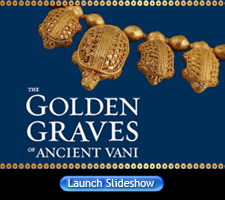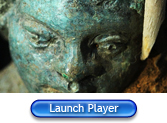|
The Golden Graves of Ancient Vani presents an array of precious objects from the ancient kingdom of Colchis, in what is today the Republic of Georgia. The excavation of a series of rich burials and other discoveries at the city of Vani have revealed a highly developed culture that had its own religious and artistic practices, yet also embraced and adapted influences from neighboring peoples.
Highlights of the exhibition include spectacular assemblages of jewelry that display the talent and skill of local goldworkers, groups of imports from the Greek world and the Persian Empire, a series of enigmatic ritual figurines, and a life-size bronze torso. In addition, four bronze lamps that were discovered in 2007 are being displayed together in the exhibition for the first time. Two have been conserved by the Getty in collaboration with the Georgian National Museum.
Explore the exhibition:
Vani's Golden Graves | Ritual Figurines | Bronze Lamps | Exhibition Credits
|
 |
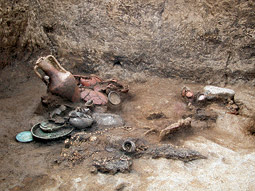
 |
 |
Detail of a grave excavated in Vani in 2004, showing a variety of metal vessels buried with the deceased
|
 |
 |
Known in myth as the destination of Jason and the Argonauts in their quest for the Golden Fleece, the kingdom of Colchis was renowned as a region rich in gold. Excavations at the inland site of Vani have confirmed this reputation. Since the 1930s, archaeologists have uncovered 28 burials dating to about 450–250 B.C. The bodies of the elite were typically adorned with a resplendent array of gold jewelry. Evidence from the site indicates that much of this jewelry was locally made.
The graves were usually covered with pebble mounds, and iron nails found in some of the burials suggest that wooden constructions were set inside. The deceased were sometimes accompanied by a number of servants and animals (such as horses and dogs), presumably sacrificed as companions for the afterlife. A variety of vessels and other grave goods were also deposited with the dead, many of which provide evidence for banqueting in the local funerary rituals.
|
 |
 |
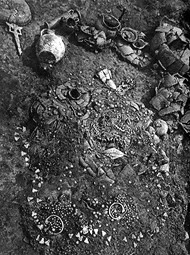
 |
 |
Detail of Grave 11 during excavation in 1969
|
 |
A Woman's Burial: Grave 11 (about 450 B.C.)
Grave 11 is the earliest burial in the exhibition. It contained four bodies inside a wooden structure and, outside it, a horse with iron bits.
Although all four bodies wore jewelry, one, a woman, was much more elaborately adorned, indicating her elite status. The many grave goods placed around her head and near her body include a number of imports from Athens, revealing the extent of Vani's contact beyond the Black Sea and reflecting a taste for luxury wares imported from the West.
|
 |
 |
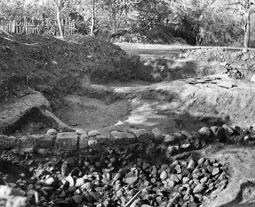
 |
 |
Detail of Grave 6 before excavation in 1961
|
 |
A Young Woman's Burial: Grave 6 (400–350 B.C.)
Grave 6 was excavated in 1961. Bone analysis indicates that the deceased was a woman, approximately 25 years old. In contrast to other adult burials in this exhibition, no servants or animals accompanied her in death.
The grave goods consist of locally made goldwork, such as the distinctively Colchian diadem with hanging temple ornaments, as well as imported objects. These include glass vessels probably made on the Aegean island of Rhodes, and a pectoral produced in the Persian Empire but refashioned in Colchis.
|
 |
 |
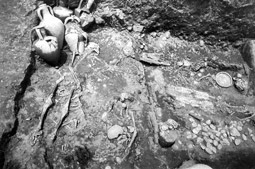
 |
 |
Detail of Grave 9 during excavation in 1969
|
 |
A Warrior's Burial: Grave 9 (350–325 B.C.)
Excavated in 1969, Grave 9 contained the body of a warrior, as well as two servants and a dog. The burial of the servants with the warrior finds parallels with the practices of the Scythians to the north.
The grave contained spearheads, daggers, thigh- and shin-guards, fragments of an iron shield, and bronze and iron arrowheads, as well as gold jewelry and terracotta vessels. The presence of a coin of Philip II of Macedon (359–336 B.C.) dates Grave 9 to the third quarter of the fourth century B.C. The coin seems to have been placed on the warrior's tongue, following a Greek funerary custom.
|
 |
 |
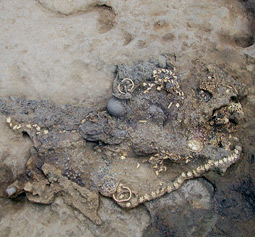
 |
 |
Detail of Grave 24 during excavation in 2004
|
 |
An Elite Burial: Grave 24 (350–300 B.C.)
Grave 24 was excavated in 2004. The deceased, whose gender is at present unknown, was buried with a remarkable array of locally made gold jewelry, including an elaborate headdress, necklaces, bracelets, and rings. Even the clothing was adorned with gold, in the form of bird-shaped appliqués. Thousands of multicolored beads embellished the burial shroud, creating a brilliant polychrome effect.
Like most other burials in this exhibition, Grave 24 also contained servants and animals—in this case, four servants and a horse—which had been sacrificed as part of the funerary ritual. Also typical was the inclusion of drinking vessels, many of which were imports. These reveal not only the significance of feasting in funerary ritual, but also the value of foreign goods among the elite at Vani.
|
 |
 |
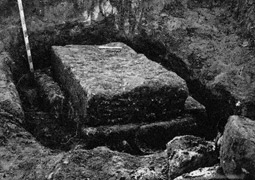
 |
 |
View of Grave 4 during excavation in 1948
|
 |
A Child's Burial: Grave 4 (300–250 B.C.)
This grave of a three- or four-year-old girl was uncovered in 1948. Though young, she too was provided with a rich burial. She wore gold ornaments including a headdress adorned with rows of rosettes, bracelets, earrings, and a torque. The quality of her jewelry suggests that she was the daughter of an elite family.
|
 |

 |
 |
Figure with a Headdress and Jewelry, Colchian, 300–200 B.C. The Georgian National Museum
|
 |
 |
|
|
 |
In addition to the burials, other discoveries at Vani have shed light on Colchian culture. Most compelling are seven metal figurines, dating to 300–200 B.C., that have been discovered both in and near sacred structures at Vani. Adorned with gold jewelry and apparently wrapped in decorated garments, the figures were carefully buried in a way that seems to mimic the human burials at the site. Their precise function remains unclear, but they probably related to local religious and funerary customs.
This figurine (left) was placed between terracotta tiles that were presumably meant to function like the wooden constructions used in human graves. The figurine was adorned with gold jewelry, and imprints of cloth suggest that it was wrapped in a decorated garment or shroud.
|
 |
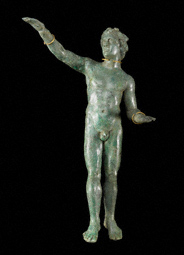
 |
 |
Satyr with Jewelry, Greek and Colchian, 300–200 B.C. The Georgian National Museum
|
 |
 |
|
|
 |
Six of the seven figurines found so far were made locally. The seventh—a bronze satyr (left) identifiable by his pointed ears and ivy wreath—is a Greek import, and demonstrates how imported objects could be adapted for use at Vani.
The tail and whatever may have been held in the left hand were removed, and the satyr was adorned with a gold torque (neck ring) and bracelets and wrapped in a shroud. The transformed statuette was then deposited in a pit within a sanctuary.
|
 |
 |
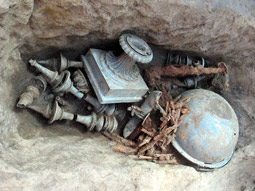
 |
 |
The lamps were found in a hoard deposited in a rock-cut pit. Visible here are a basin and stand, couch legs, spearheads, and one of the lamps (center). The other three lamps were found at the bottom of the pit.
|
 |
Through the auspices of the Georgian National Museum and the Institute for the Study of the Ancient World at New York University, four bronze lamps are being exhibited together for the first time. They were discovered in the summer of 2007 in a rock-cut pit near the walls of ancient Vani. Two of these lamps were recently conserved at the Getty Villa in collaboration with the Georgian National Museum.
The lamps were part of a hoard of metal objects found about 20 meters from the remains of a temple complex. It appears that the hoard was deliberately, though hurriedly, hidden, perhaps during a time of crisis—Vani suffered two waves of destruction around 50 B.C.
The lamps and the hoard to which they belong offer numerous avenues for new research in the study of Vani. That they exist at all is of great importance, since so much ancient bronzework has been melted down. Their secure context and their creative use of Hellenistic Greek subjects render them immensely valuable indicators of activity at Vani during its last phase.
Study of the lamps will continue with further scholarship and archaeological investigations.
|
 |
|
The tour of The Golden Graves of Ancient Vani has been organized by the Institute for the Study of the Ancient World at New York University in partnership with the Ministry of Culture, Monuments Protection, and Sport of Georgia; the Georgian National Museum; and the Vani Archaeological Museum.
Generous funding was provided by the Villa Council.
All archival and excavation images courtesy of the Otar Lordkipanidze Center for Archaeological Research, the Georgian National Museum.
|
 |
